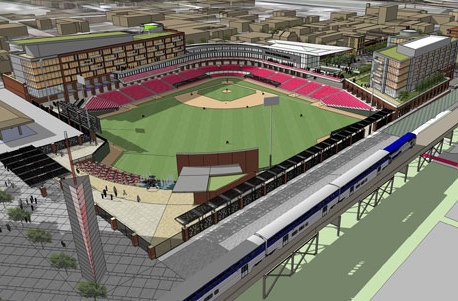Council passes resolution on Revitalize RVA
After hours of deliberation, Richmond City Council voted last night to continue negotiations with the city’s administration towards the Shockoe redevelopment plan.

Richmond City Council passed, on Monday night, a resolution to continue negotiations with the city administration surrounding the planning of the Shockoe redevelopment plan. The council voted 6-3 to support the agenda item after hours of citizen comment and deliberation.
Council President Charles Samuels (District 2), Councilwoman Reva Trammell (District 8), and Councilman Parker Agelasto (District 5), voted against the resolution.
The overall redevelopment plan, “Revitalize RVA,” was introduced by Mayor Dwight Jones in early November and includes a baseball stadium in Shockoe bottom, redevelopment of the Boulevard, and Slavery and Freedom Heritage Site. The council’s resolution includes a more than $76 million budget for the project.
Further negotiations between the city administration and the council will be the next step for the plan. The administration is set to make a final proposal to the council in late March and expects to vote in June.
The council chambers overflowed on Monday with citizen activists hoping to speak on the proposed resolution. City hall opened the second floor conference room to accommodate citizens who could not fit inside the chambers. Dozens of people spoke on both sides of the issue, and a lively discussion lasted for more than five hours.
Speakers opposing the Shockoe Bottom development resolution criticised disabled planning, a need for more thorough investigation, and irresponsible spending priorities.
A particular point of contention was the proposed Slavery and Freedom Heritage Site, which many say does not do enough to address Richmond’s past.
Martha Rawlins, a retired citizen of the Byrd Park neighborhood, compared healing Richmond’s history with slavery to her own husband’s long-term healing from a deep stab wound over the summer.
“We put band-aids on the wounds of slavery for all these years, we wouldn’t look at it we didn’t want to know what was happening,” she said. “We want to honor and remember and heal. So I would ask us not to put up a ball park and end the chance for this to be a true healing.”
Rawlins said the proposed slave museum was just an “accommodation.”
After an hour of comments opposing the resolution, an equally long line of supporters was heard by the council. Samuels had to remind audience members more than once to “behave like adults” during the discussion.
Virginia House of Delegates member Delores McQuinn, school board member Derick Jones, and former city councilwoman L. Shirley Harvey voiced their support of the resolution.
“I ask city council to move forward this effort, to tell the story of the enslaved Africans, and so that 100 years from now little girls and boys … would understand the importance of a daunting and a complex story of tragedy and triumph and have sometimes forgotten and ignored history,” McQuinn said.
“I know that everyone will not support it, as has been shown tonight … but sometimes we have to make hard decisions to get the best product. and sometimes it means making decisions that everyone would not be in favor of,” McQuinn said.
Following the council meeting online, hundreds of Richmonders used the #RVAcouncil hashtag as a forum for their own views.
After the open discussion period, council members discussed and approved three amendments to the item, and voted down a large amendment introduced by Samuels.
Three passed amendments to resolution:
- Administrative amendment: Solved a clerical error to adjust the total capped cost of the project from $51,325,000 to $76,987,500. Passed unanimously.
- Baliles amendments: Removed the words “moral obligation” from the resolution; relieves taxpayers from certain payment obligations if the project fails. The amendment also leveled the responsibility of developers as well. Passed unanimously.
- Newbille’s amendment: Instructs the administration to come back with a firm, documented commitment of financial support of the $30 million needed to fund the rest of the cultural heritage site outside of the city’s commitment, Newbille said. Passed unanimously.
Samuel’s amendment would have created a new traffic study, a thorough archaeological excavation before development begins, and structured more citizen input on the Boulevard plan.
In the open discussion of the resolution among council, members openly explained their various hesitations, support, and conflicts surrounding the resolution and the overall development plan.
“This resolution before us is not about being in favor or against the redevelopment of the bottom and the Boulevard. It is about getting information necessary for us to make an informed decision,” said Councilwoman Kathy Graziano (District 4).
“How do we adequately fund schools, poverty, affordable housing, public safety, and other services? How do we remain competitive with the surrounding counties in attracting businesses, residents and employees. Attracting new revenues is the answer,” she said.
Councilwoman Reva Trammell suggested putting the issue to a city-wide vote.
Samuel’s final comments before the council vote summarized most of the evening’s conflict:
“There’s a lot of good reasons for supporting this proposal, and there’s a lot of good reasons for opposing it,” Samuels said. “I think at the end of the day we can all agree on one thing, we can do better than what’s in the Bottom right now and we can do better than what’s on the Boulevard right now. We need to redevelop these two sites, we just disagree on the best way of going about it.”
City council is expecting to receive proposal on March 27 on the administration’s final proposal.
-
Recommend this
on Facebook -

Report an error
-

Subscribe to our
Weekly Digest





There are 2 reader comments. Read them.